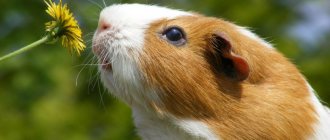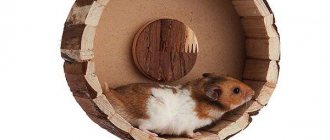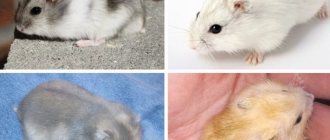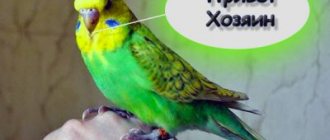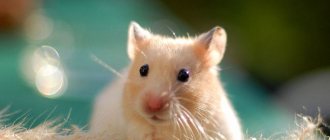The Angora hamster is not a separate breed. This is how they began to designate a variety of Syrian (also known as Western Asian or golden) rodents with abnormal fluffiness. Just like other members of this family, the Angora hamster needs a comfortable cage, quality food and clean water. But there are still some differences in the rules for keeping this furry animal.
Factors that adversely affect the lifespan of an Angora hamster
- lack of proper nutrition, violation of the basics of the rodent’s diet;
- unacceptable living conditions prior to purchase;
- harmful conditions for transporting a hamster;
- presence of diseases;
Buying an Angora hamster in Russia is not difficult, the average price is 200-350 rubles. (depending on the region and place of purchase; in a qualified pet store the price is higher than in the poultry market). Hamsters have a tendency to reproduce quickly, the offspring need to be placed in good hands, so there is the option of purchasing a rodent from friends for a nominal fee.
When getting an animal, you need to remember that buying an animal is not the only cost. Fluffy needs a cage, exercise equipment, a feeder, a drinking bowl, sawdust and food.
Reproduction
Angora hamsters reach reproductive age at 1.5 months. You can mate representatives of different breeds, you need to select partners based on weight, size and immediately remove the male - a pregnant female becomes very aggressive and can injure or kill her “husband”.
New mothers can eat their offspring - this is due to a lack of protein in the body. To preserve the offspring, feed pregnant hamsters heavily with chicken, milk and egg whites. In addition, you should not pick up newborns - the foreign smell will turn the mother away from the children and the offspring will die.
The health of hamsters and possible diseases are all in your hands. Try to make sure that these cute animals delight you for more than one year. Care will return with boundless love and trust.
What do you need to buy to keep an Angora hamster?
- cell
- drinking bowl and feeder
- sawdust
- exercise equipment and other accessories
For a comfortable stay for a hamster, it is necessary to place the house (cage) away from heat sources; constant exposure to direct sunlight is unacceptable. Fresh air is necessary, but drafts must be avoided.
Place the crate out of the reach of other pets such as cats or dogs.
It is advisable to prevent the cage rods from coming into contact with wallpaper, curtains or furniture; do not forget that this is, first of all, a rodent, and it can damage everything it can reach.
It is important to take care of the “toilet” for your pet - you can buy litter at any pet store; it is poured into the corner of the cage or on a tray, which can be taken out and washed.
It is necessary to arrange a nest for the hamster. To do this, take a house made of plywood or plastic, put hay, pieces of fur, paper or pieces of fabric on the bottom. We do not recommend using cotton wool and newspapers - cotton wool can get the paws of newborns tangled, and printing ink from newspaper sheets can cost your pet his life.
A hamster is an active animal that is constantly on the move. But in captivity, the furry has no need to get food, and his movements are limited by the walls of the house, there is no need to run or climb to escape from the enemy. For this purpose, exercise equipment has been created that will help you release energy and help you stay in shape. The most common exercise machine is the wheel; this is the homa’s favorite activity; they can run in it for a long time. Additionally, hammocks, ladders and tunnels are purchased, if the height of the cage allows - shelf-floors.
When buying a wheel for an Angora hamster, pay attention to the diameter; it should be at least 20 cm to avoid tangling in its own fur. Now you can find a walking ball - a hamster can walk around the apartment in it, you won’t lose it, and you don’t have to worry that it will get stuck somewhere and die.
How to care for an Angora hamster?
Hamsters do not require a lot of water, so there is no need for a large water bottle, especially given the juiciness of the food. You need to have two feeders, you can use any easy-to-clean container, one feeder is intended for dry food, the second for wet food.
As mentioned above, the natural need of any rodent is to chew. Therefore, it is necessary to purchase chalk (mineral) stone , if the animal does not grind down its teeth, they will interfere with normal life activities.
Nature has rewarded the Angora hamster with luxurious fluffy fur, which needs to be combed daily to remove tangled particles of sawdust and food. For brushing, you should purchase a special brush from a pet store. Bathing your pet in the traditional way is not recommended. This hygiene procedure can cause the animal to catch a cold. It is better to install a sand bath in the cage; the Angora hamster will clean its fur with grains of sand as needed.
Beautiful wool is not only a beauty, but also a burden
The only minor disadvantage of the Angora hamster is the need for hair care. Particles of food, sawdust and other debris can get tangled in long fur, so it is necessary to comb out the fluffy one. A simple toothbrush is enough for this.
It is advisable to replace sawdust with a special wood filler in the form of granules.
In pet stores you can purchase cleaning powder specially created and adapted for such animals. Under no circumstances should contact with water be allowed; the hamster should not be bathed in water; this could cause it to die or get sick. Regular brushing will not only keep the animal clean, but is also necessary for an attractive appearance.
Habitat and distinctive features
Under natural conditions, fellow Angoras live in the mountains of the Caucasus and Central Asia.
The Angora hamster is not a separate breed. This is the same Syrian hamster, only with much longer hair. This is the result of mutations in genes. Another difference lies in the color palette.
The common Syrian rodent has only one color of fur – yellow. This color helps it survive in natural conditions, helping it hide in dry grass. The peculiarity of Angoras is that their fur coat comes in different colors: cream, gray, spotted, black and ash. Moreover, with age the color becomes darker.
Individuals with long hair and different shades have always appeared in families of Syrian hamsters. But their characteristics prevented them from surviving in natural conditions. But in captivity, with proper care, these babies adapt perfectly to living conditions . Therefore, breeders began to specifically select unusual representatives of the Syrians and fix the mutated characteristics.
large cheeks are whiter than other hamsters
Angora hamster nutrition
The most basic question is what to feed and how to make the rodent’s diet balanced.
Due to the fact that this is an artificially bred breed, the Angora Homa needs good nutrition and sufficient vitamin content. A proper diet consists of:
- fiber – flax, millet, oats – every day;
- proteins of plant origin - berries or fruits, vegetables, nuts and dried fruits - every day;
- animal proteins – cottage cheese or kefir, chicken without added salt – twice a week;
Acceptable food for hamsters:
- purchased mixtures (cereals/dry fruits) – for rodents;
- treats in the form of granules or sticks, cookies, biscuits - purchased in a specialized store, adapted for hamsters;
- sunflower seeds, melon or pumpkin - without fanaticism;
- egg white – once every two weeks;
- fruits - almost everything is allowed: apples, apricots, grapes, etc.;
- vegetables - carrots or pumpkin;
- berries - strawberries or raspberries, but rarely and little by little;
- natural yogurt;
- porridge – for children or without sugar;
- plantain leaves, dandelion, dill/parsley, lettuce.
When feeding fruit, be sure to remove the pit. Fruit pits contain acid, which can be fatal to your pet.
The Angora hamster's diet should be balanced and varied. It is allowed to use special foods sold in pet stores as a basis, for example, Little One, Sultan or Lucky. In addition to this, the furry pet’s menu is supplemented with other healthy products.
What is possible
For the normal development of your four-legged friend, his daily diet should include a lot of fiber and vegetable protein:
- oats;
- barley;
- corn;
- sunflower seeds;
- peas;
- grass;
- vegetables;
- fruits;
- berries;
- nuts (in small quantities).
Also, once a week it is necessary to give the Angora hamster foods containing animal protein: cottage cheese, a piece of boiled white meat or liver, a little boiled egg white.
What not to do
It is strictly forbidden to treat your Angora hamster with dishes from your own table. The consumption of sweets and some fruits and vegetables is also prohibited:
- mango;
- citrus;
- persimmon;
- a pineapple;
- watermelon;
- potato;
- onion;
- garlic;
- sorrel;
- mushrooms.
For normal metabolism, you need to supply fresh water - filtered or bottled - to the hamster's cage every day.
Ensuring a decent existence for a pet is not difficult; in return you will receive a devoted pet who will be a source of good mood.
Variety of species
In total, there are about 250 varieties of hamsters in the world; in our country, no more than one and a half dozen species of these funny animals are widespread. Here are just a few of them:
- Domestic or ornamental: common hamster;
- angora;
- Djungarian hamster;
- Sungursky;
- Taylor's dwarf;
- Roborovsky's hamster;
- Siberian, white hamster;
- Campbell;
- golden or Syrian hamster.
- Mongolian;
Among this fluffy splendor, there are also bald hamsters - the inquisitive minds of experimental geneticists have reached these cute pets.
Training
Angora hamsters are easy to train. You should start teaching your pet tricks before he is a month old. Later attempts at training will not be successful. With proper upbringing, your furry pet will be able to perform several simple tricks:
- respond to your name;
- run in circles;
- stand on your hind legs;
- sit on the owner's shoulder;
- look for a treat.
Before training, you should make sure that the hamster is healthy. Otherwise, classes will have to be postponed. It should also be taken into account that well-fed animals are unlikely to willingly carry out the owner’s commands.
Diseases
Angora hamsters, like other animals, are not immune to diseases. Sometimes diseases develop against the background of poor heredity. Only most often rodents get sick due to poor care or an incorrectly selected diet. The list of diseases of Angora hamsters is quite wide:
- diseases of the gastrointestinal tract (diarrhea, constipation);
- diseases of the genitourinary system (cystitis, kidney infections);
- inflammation of the cheek sacs;
- mites;
- cold;
- malignant and benign tumors;
- injuries, painful shock.
Self-treatment will only harm the hamster. If signs of illness appear, you should immediately contact a veterinarian.
How to determine the breed
You can determine the breed of a hamster by studying its characteristic features, color, tail length and size. It is worth carefully examining all these characteristics so as not to make a mistake with your choice.
At the end of the article, I would like to share one interesting fact about hamsters: almost all Syrian hamsters descended from one female, who gave birth to twelve babies in 1930.
Content Features
Cell
A cage for a furry pet should be spacious, with an area of 1.4 m2. Required interior elements:
- Filler. Instead of sawdust, which constantly gets tangled in long hair, it is better to sprinkle wood pellets on the bottom of the cage.
- Little house. Rodents love to sit in a cozy nest, away from prying eyes. When choosing a house for your pet, you should take into account the parameters of windows and doors - the hamster should walk through them freely with full cheeks.
- A drinking bowl and two feeders - for dry and wet food.
- Wheel. Angora hamsters love to run, especially in the evening. Taking into account the size of the animal’s body, the diameter of the device should not be 20-25 cm.
- Stairs and labyrinths. Hamsters require variety, so in addition to the standard running wheel, it is worth installing additional equipment.
The lock of the cage must be strong so that the nimble animal does not open it and escape.
Additional terms
Owners of Angora hamsters need to take into account several nuances when keeping animals:
- representatives of this breed are loners, they do not tolerate the presence of other hamsters in the cage;
- At night, the activity of Angora hamsters increases, so in the evening it is better to take the cage to a room where no one sleeps;
- long-haired pets love warmth; at temperatures below +10 degrees they hibernate;
- drafts and cold lead to colds in Angora hamsters;
- the appearance of a specific unpleasant odor signals that it is time to wash the cage.
Description of the animal
The fluffy hamster was named by analogy with Angora cats, rabbits and goats with their amazing fur, and the Tebyls were named after Ankara, or Angora (as they used to say), since all the animals were originally from Turkey.
Appearance
Externally, Angora hamsters resemble guinea pigs. They have long, thick fur and a decent size for their species. In males, the hair length reaches 6 cm. In females, this figure is 3 times less, so only boys can be considered Angora hamsters. The girls are of the Syrian breed.
An adult animal weighing about 180 g reaches an average of 10–12 cm in length. The front legs are small. Like many other representatives of this family, Angora hamsters have large cheek pouches, but the tail is completely absent.
In nature, Syrian hamsters with a camouflaged golden color usually survived. Any other color stood out too much on the sand and attracted predators. However, for breeders such a defect was very desirable.
Over time, fluffy hamsters of the most unusual colors appeared:
- gray;
- snow-white;
- cream;
- black;
- ashy;
- tortoiseshell.
Character and habits of the Angora hamster
In the wild, miniature hamsters require a lot of personal space. They try to dig their complex burrows away from their relatives and live alone, walking tens of kilometers per night in search of food and building material for their homes.
Domestic varieties of hamsters have retained the instincts of their ancestors and still know only 2 modes - sleep and movement. This explains the annoying rustling and squeaking sounds coming from the cage at night. Angora hamsters are generally more active at night. If they are disturbed during daytime sleep, they may bite.
They do not have particularly warm feelings towards their relatives and will not tolerate a stranger in their cage. If the neighbor is also a male, then the matter will end in a fight or even the death of one of the hamsters.
Despite this, Angora hamsters are sociable, intelligent and peaceful creatures. They get along with children and love to be talked to. At a young age they are easy to train and learn simple tricks.
Hamster health and life expectancy
These small animals usually do not have serious health problems, but they are susceptible to colds, so the place where the Angora hamster lives must be reliably protected from drafts. It is also strictly not recommended to bathe animals.
Health problems arise in hamsters when they are old or due to improper diet and care. They may suffer from colds, flu, cystitis, suffer from lichen or diseases of the urinary system, indigestion, constipation, rectal prolapse.
Signs of health problems are: irregular bowel movements, lethargy or excessive activity, poor appetite. In this case, the animal should be immediately shown to a veterinarian.
In the wild, the Angora hamster lives no more than two years. Like all rodents, they are the main prey for birds of prey, foxes, stoats, badgers, jackals and snakes, but the population is restored in huge numbers due to the high fertility characteristic of this order of mammals.
In captivity, the life expectancy of fluffy hamsters has doubled. On average it is 3–4 years. A healthy pet with proper care and a balanced diet can sometimes live up to 5 years. There was a recorded case where an Angora hamster lived to be seven years old.
